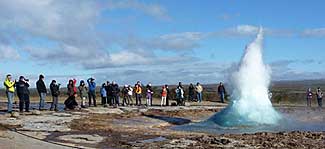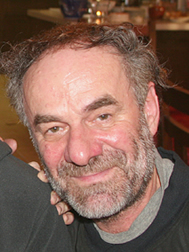 |
|
POSTCARD FROM the MAUI COFFEE FARM, HAWAII, Part One |
|||
Story and Photographs by Larry Turner |
|||
A gentle Hawaii northeast breeze soothes me as I write these words from the upstairs office portal at the Maui Mountain Coffee Farm located on the slopes of Haleakala volcano. A symphony of birds chirps outside. A variety of color abounds in the blossoming trees, scrubs and plants on the 2,650-foot elevation farm in the Upcountry region known as Olinda, several miles uphill from the Paniolo cowboy town Makawao. Views out my multi-port window include the blue Pacific beyond Paia, Haiku and Kahului, and the alluring tropical jungles on Maui’s west-side. I sip my homemade morning joe and marvel at the beauty and peace before my eyes. THE COFFEE FARM and SATURDAY UPCOUNTRY MARKET I came in late July to help care for my friend Bobbi Becker’s coffee farm, while she escaped to get a fix on the mainland, including kayaking the Colorado River through Grand Canyon National Park, a 230-mile journey. I will stay until early September - my main task—brewing the coffee for the Upcountry Farmers’ Market (55 Kipoaa Place, Makawao, 808-572-8122) every Saturday, 7am to 11am. With her volcano dark roast, Bobbi won Maui’s Best Coffee award at their 2018 Annual Cupping Event. In 2017 she placed 2nd on Maui and 5th out of 107 entries in the Hawaiian inter-island competition, which includes all of the great coffees of Kona. Many say her coffee is the best they’ve ever tasted. I would second that!
THE ROAD to HANA and CHARLES LINDBERGH’S GRAVE The first Sunday after market, new friend Natalie (she rents Bobbi’s cottage on the property) and I loaded chairs, camera gear, her dog Franklin and food for a picnic, and commenced to travel toward Kipahulu and the Palapala Ho’omau Church (built in 1857) where the famous aviator Charles Lindbergh rests along the rugged coastal shore of the Pacific’s Alenuihaha Channel. We followed the Upcountry Hula Highway (37) which connects to the Pl’ilani Highway (31). Eventually the highway name changes to the Hana Highway. I prefer taking this southeastern route counterclockwise to Hana because there is considerably less traffic than the northern Road to Hana route that starts from Kahului, which is traveled by most tourists. In the Upcountry (2,000-4,000-foot elevation), the Kula Lodge, the Kula Botanical Gardens and the Tedeschi Winery are worthy stops. The Kula Lodge’s restaurant has amazing views of the Pacific and Maui west. There is also an enchanting garden with a plethora of exotic blooming plants to explore on a winding vertical path beside the restaurant. Lodge prices are from $310-$370 an evening. Not in my budget, but certainly in the budget of some. Down the road is the charming little hamlet of Keokea, a must-stop for breakfast or lunch at Grandma’s Coffee House. The down-home feel-good food is superb and the bakery pastries sumptuous and hard to resist. Sorry keto diet, you’re canceled for a day. I’m a sucker for carrot cake and theirs is the best. Grandma was 16-year-old Minnie Franco (originally from Puerto Rico) who hand picked, dried, and roasted wild coffee beans from Haleakala’s slopes back in 1918 and traded her brews with the nearby Paniolos and ranchers. Her 100-year-old coffee grinder is displayed in the coffee house, along with a large mortar and pestle she used to initially break down the beans. Not far down the road from Keokea is the historic Sun Yat-sen Park, named after Sun who lived in Hawaii for a time, attended school to sharpen his knowledge about democracy, then returned to China where he led the overthrow of the last emperor in 1912. The coastline is rugged and dry on this side of the island with few beaches. The views though are spectacular—up the flanks of Haleakala to canyon ravines carved by chiseling water flows from occasional torrential rains. You get to see the immensity of the young volcano, more so on this side compared to views from the northern and eastern Road to Hana where the verdant jungle rules and overshadows the road, allowing few vistas of Haleakala’s magnitude. This southern route reminds me of the Hart and Steens Mountains of my home state of Oregon. The closer one gets to Kipahulu, the more verdant the vegetation and more gnarly the road conditions. In several places, only one vehicle can squeak by; the horn is liberally used when approaching hairpin turns. After negotiating one steep area with the ocean straight below us and no guardrails, we found a small beach pullout where we parked to exhale ... and then decided to have a picnic nearby, under a lone shade tree with dramatic ocean views. There are no signs marking where Lindbergh is buried. Part of the adventure is finding his grave on your own.
WINGFOILING KANAHA BEACH Near the Kahului Airport is Kanaha Beach, where Hailku resident and friend, Ely Spivack, was kind enough to take me. In my several previous trips to Maui, I had no idea that this locals beach existed. It has become a mecca for wingfoilers and windsurfers, Ely being one with 30 years experience, mainly windsurfing. The scene was like viewing life through a kaleidoscope. Framed by wonderful old large beach trees and a park setting of green grass, the ocean was a swarm of colorful wingfoilers and windsurfers, like damsel and dragon flies tracing here and there, and yonder. I was mesmerized by the scene. I took my camera gear and Ely carried his foil gear to a shady area where he introduced me to many of his middle-aged friends, all windsurfers and foilers. Gingerly (three weeks earlier I had had medial meniscus knee surgery) I took a seat in a beach chair and set my camera on a tripod with a large telephoto lens. I spent two days doing this. The youngest athlete I photographed was 12-year-old Kaden Pritchard; the oldest, an 85-year-old gentleman who was treated like a rock star by the other wave riders. Wingfoiling is a new sport (3-4 years old). Ely mainly does it now instead of windsurfing because “it eliminates most of the stress and effort of wind surfing due to the lack of resistance with the small surface area of the foil underwater, as the board does not touch the water when you are 'on foil.'” The ability to go upwind is also greatly enhanced. And the lack of a connection with a sail and mast connected to your board, as in windsurfing, allows you to completely de-power the wing and ride the wave or swell effortlessly, what is called “flagging the wing.” “Windsurfing still has advantages in bigger, breaking waves,” Ely said. “But there’s nothing like feeling the magic carpet ride under your feet, whether on flat water or downwind riding on a big wind swell bump. It is exhilarating and JOYFUL.” In watching wingfoiling, you get the sense that a person is walking or running on water. It has a levitation mystery to it. The feeling must certainly compare to dry powder skiing when you feel you are floating down the mountain. Wingfoiling looks like water ballet. At my age, if there is one more sport to add to my adventure repertoire, it would be wingfoiling. All that I have to do now is to come up with an initial investment of $2000 to $4000. I think that I need to get my knee healed up before I ponder this much longer though ... and Maui seems to be the perfect location for such.
BEACHES BEACHES BEACHES Of all of the Hawaiian Islands, Maui is noted as having the most and best beaches. Since my knee surgery, I have not been able to go into the water. Doctor’s orders until my incisions heal. Well, at the moment of this writing, that day has arrived. In my next HOA, Part Two story, I’ll explore what I’ve found. In the meantime, I’m placing some photos here of the beaches that I’ve been to as only an onlooker, including Baby Beach, Kanana Beach, Ma’alaoa Beach and a few other beaches in the Kihei area. Enjoy.
________________________________________ IMPORTANT INFO: ABOUT THE AUTHOR
|
.jpg)
.jpg)
.jpg)
.jpg)
.jpg)
.jpg)
.jpg)
.jpg)
.jpg)
.jpg)
.jpg)
.jpg)
.jpg)
.jpg)
.jpg)
.jpg)
.jpg)
.jpg)
.jpg)
.jpg)
.jpg)
.jpg)
.jpg)
.jpg)
.jpg)
.jpg)
.jpg)
.jpg)
.jpg)
.jpg)
.jpg)
.jpg)
.jpg)
.jpg)
.jpg)
.jpg)
.jpg)
.jpg)
.jpg)
.jpg)
.jpg)
.jpg)
.jpg)
.jpg)
.jpg)
.jpg)
.jpg)
.jpg)
.jpg)
.jpg)
.jpg)
